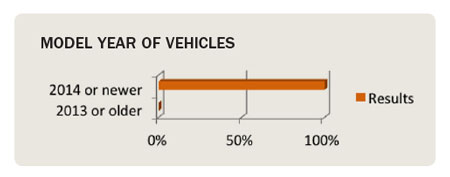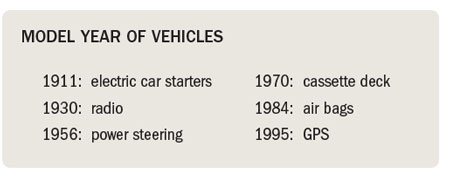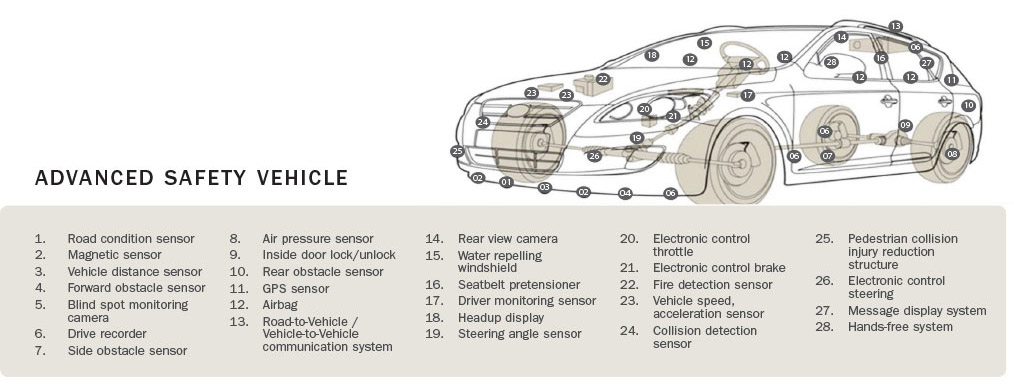Explaining the Internet of Vehicles
By Chelsea Webster
Let’s start out with a quick poll:
What model year is your vehicle?
Okay so there was only one respondent, but I think it’s safe to say that with new car sales of 3.8 million in Canada1 and 34.5 million in the US in the last 2 years2, there are a LOT of vehicles on our roads that are a 2014 model year or newer.

Why does this matter?
Consider this quick rundown of the major car advances to land in our vehicles.

So, now that internet connectivity is showing up in cars, you can see how such a big change is cause for discussion. We’re basically taking the Internet of Things (if this term isn’t familiar, it’s the concept that everything is now connected on the internet – from your home thermostat to your heart rate monitor to the security camera on the street4) and applying it to vehicles. This concept of the fully connected and communicative vehicle is called the Internet of Vehicles (or IoV as we’ll refer to it).
IoV Fundamentals
Overall, the IoV is a massive network of connection points to the internet which are in constant communication. It’s meant to guide and supervise vehicles while providing abundant multimedia and mobile Internet application services. There are several components to understand within IoV, so let’s go over a few details.
Why would we want this? There are four main benefits of IoV5: safety (if you know the car in front of you is stopping, you can brake early); environmental damage mitigation (use less horsepower to reduce emissions); energy conservation (maximize efficiency in gas consumption); and intelligent communication (avoid a traffic jam, construction, or pay for parking).
Who is the car communicating with? There are several important groups vehicles are communicating with: other vehicles (V2V), the road (V2R), humans (V2H), and sensors (V2S)6.
What are the automakers getting out of it? Agreed, automakers would not install this technology into their vehicles without any benefit for themselves. A few pluses for them: real-time software updates (think of how easy it would be to tell owners about a recall); usage data (they can see your driving habits *note to self, stop speeding*); and product cross selling (it’s time for an oil change at our service center, let us help you book that appointment).
What exactly is connected? GPS/routing, cameras, brakes, the steering wheel, driver health/voice/alertness, social media, alarms, messages, tracking sensors, content download/upload… to name a few things. Here’s a fancy diagram for you to look at as well7:

So how does this all work?
The first thing you need is a global ID terminal (GID). Right now, this can either be mounted/tethered (i.e. via plugging in your smart phone), or integrated/embedded (the automaker builds in an antenna and chipset). The GID uses your license plate as an identifier and integrates the sensors, network, and all the other necessities8.
Another important technology is the Vehicular Ad-Hoc Network (we’ll call that VANET because that’s what everyone else calls it). It uses each connected vehicle as a node and creates a spontaneous mobile network with all the vehicles (within a 100-300 meter range). This is one type of cloud (a vehicle to vehicle); but just to confuse you more there are also two other types (Edge and Internet). Anyhow, the end result is your chatty car now has lots of friends to talk to. Voila!
Are vehicles other than our personal ones using IoV?
They sure are! A few examples are:
- public transit (in Minneapolis you can connect to Wi-Fi on any bus or train);
- ride sharing and taxis (getting the closest car to an exact location and maximizing usage rates)
- shipping (making sure freight is tracked and cared for while en route9)
- rickshaws (in New Delhi they really did install GPS on all the rickshaws to prevent drivers from taking ‘questionable’ routes)10
Relate this back to autonomous vehicles
Okay. So far we know that our personal vehicles can be connected to the IoV. Well, in the exact same way, albeit without the ability to opt out, so are all autonomous vehicles. This really is critical for them to go ahead with collision warning, preventing traffic shockwaves11 (you know when everyone mysteriously brakes even though there are no hazards? That’s a shockwave), organize platooning (travelling in packs), and analyze road conditions.12 And since we’ve all agreed that mass production of autonomous vehicles will be underway in 2020, and provide a market of $2.9 Billion13 – we should probably make sure IoV and autonomous vehicles are happily working together.
There must be a downside
First and foremost is internet security – remember the cyber-attack that shut down thousands of websites back in October 2016?14 Well the same potential threat exists with the IoV. Now, the internet as a whole isn’t about to go down15 but someone could in theory hack your car and take you on quite the ride – either by controlling the GPS or flat out crashing it. Or anything in between. To minimize this risk, IoV uses the Edge cloud I mentioned above. It has the highest security and mitigates this risk.
There’s also the challenge of a universal set of technology standards16. We’re getting closer – but there are still a plethora of technologies out there. Time will tell on this one.
I don’t think I really put your mind at ease after that last one so let me balance things out by introducing you to the National Institute of Standards and Technology (NIST). Their goal is to make secure connections to access the internet with any and every connected device17 so that you don’t have to worry about your car or phone or home being under cyber-attack. Plus they have the National Strategy for Trusted Identities in Cyberspace18 which describes how internet connections can be secure, resilient, easy and privacy-enhancing.
What’s next?
Well, this is really just the first major leap towards autonomous vehicles being the norm. Another major win will be when other sectors start collaborating as well (like energy, healthcare, environment, and manufacturing sectors). For example, if the vehicle manufacturer builds the GID and other hardware required into the vehicle at the factory level that will ensure every new car is connected. Or perhaps your car knew you were having a heart attack and about to crash your car, but took over driving and navigated to the nearest emergency room. Maybe your car even checks the weather for you before you drive to work, notices how cold it is and turns on the heat for you. It even connects with your winter tires in storage and makes you an appointment to get them changed (I need this… badly). The potential for IoV is really as vast as the internet.
This article was informative but I want more
Haven’t learned enough from reading this? Here are a few more sources you may want to check out (or not, because a 242 page book on the subject is really going to get into detail). https://www.amazon.ca/Intelligent-Vehicular-Networks-Communications-Architectures-ebook/dp/B01LR8FBPC
Visual learner? Here are a ton of complicated diagrams:
http://tf.nist.gov/seminars/WSTS/PDFs/1-0_Cisco_FBonomi_ConnectedVehicles.pdf
White papers can also be a nice succinct yet well researched source, especially this one that really covers the progression of IoV: http://nrlweb.cs.ucla.edu/publication/download/794/1569843237.pdf ν
Please get in touch via email (Chelsea.webster@getparkplus.com)
or twitter (@getparkplus) with any comments or questions you have!
1. StatsCan: http://www.statcan.gc.ca/tables-tableaux/sum-som/l01/cst01/trade12-eng.htm
2. Wall Street Journal: http://www.wsj.com/articles/u-s-car-sales-poised-for-their-best-month-ever-1451999939
3. I omitted a few, they’re here: http://uk.businessinsider.com/internet-of-things-connected-smart-cars-2016-10
4. What is the IoT? http://internetofthingswiki.com/iot-applications-examples/541/
5. http://mddb.apec.org/Documents/2014/TEL/TEL50-PLEN/14_tel50_plen_020.pdf
6. http://wfiot2015.ieee-wf-iot.org/IOV%20-%20IOT%20FORUM%20Milan%20dec%202015.pdf
7. http://tf.nist.gov/seminars/WSTS/PDFs/1-0_Cisco_FBonomi_ConnectedVehicles.pdf
8. Liu Nanjie is the real genius here: http://www1.huawei.com/enapp/28/hw-110836.htm
9. Arbor Technologies has a great video explaining applications: https://www.youtube.com/watch?v=sWZjDBHS6-c
10. http://www1.huawei.com/enapp/28/hw-110836.htm
11. http://wfiot2015.ieee-wf-iot.org/IOV%20-%20IOT%20FORUM%20Milan%20dec%202015.pdf
12. http://tf.nist.gov/seminars/WSTS/PDFs/1-0_Cisco_FBonomi_ConnectedVehicles.pdf
13. Numbers and stuff: http://uk.businessinsider.com/internet-of-things-connected-smart-cars-2016-10
14. https://www.theguardian.com/technology/2016/oct/21/ddos-attack-dyn-internet-denial-service
15. CIRA is the real expert: https://cira.ca/blogs/public-domain/how-internet-works-%E2%80%93-philosophical-explanation
16. http://mddb.apec.org/Documents/2014/TEL/TEL50-PLEN/14_tel50_plen_020.pdf
17. NIST details: https://www.nist.gov/itl/tig/our-focus
18. Official White House document here: https://www.whitehouse.gov/sites/default/files/rss_viewer/NSTICstrategy_041511.pdf



